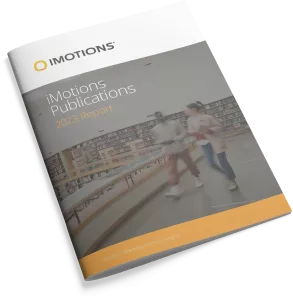-
Alpha band prefrontal asymmetry does not underlie pain approach-avoidance: Results from two EEG studies approach-avoidance: Results from two EEG studies
Pain research is often focused on escape from pain or approach of relief, yet individuals with chronic pain make complex choices to face their pain to satiate other drives (approach-avoidance conflicts). An abundance of research has indicated that prefrontal alpha band asymmetry (PFA) underlies approach-avoidance in general, but there is limited information about whether PFA […]
-
EEG-Based Neural Synchrony Predicts Evaluative Engagement with Music Videos
The use of neuroimaging to predict individual and population-wide behaviors, also known as neuroforecasting, was long applied to estimate movie popularity. Only recently, EEG-based neural synchronization, which is indicative of engagement, was found as a valid predictor of the listening behavior of the population. However, the population’s evaluative responses to the songs were not incorporated. […]
-
Positive Technology: Developing Positive Affect Through Implementing Positive Psychology in an Interactive Search System Design
There is no doubt that our lives are becoming more digital, reliant on interactive devices or digital services. One of the most significant changes observed in recent years is the large and growing number of people obtaining health information online, making it the most popular medium for obtaining health-related information. Online access to health information […]
-
Examining the Impact of Stress and Fear of COVID-19 on Transit Travel
The COVID-19 pandemic altered daily life by forcing governments to issue measures for the prevention of the spread of the disease such as stay-at-home orders, requiring face coverings, and maintaining physical distancing, among others. This caused a significant disruption in every aspect of people’s lives. This disruption was prominent in the transportation sector where travel […]
-
Using Machine Learning with Eye-Tracking Data to Predict if a Recruiter Will Approve a Resume
When job seekers are unsuccessful in getting a position, they often do not get feedback to inform them on how to develop a better application in the future. Therefore, there is a critical need to understand what qualifications recruiters value in order to help applicants. To address this need, we utilized eye-trackers to measure and […]
-
A Multimodal Emotion Perspective on Social Media Influencer Marketing: The Effectiveness of Influencer Emotions, Network Size, and Branding on Consumer Brand Engagement Using Facial Expression and Linguistic Analysis
Social media influencers rely on emotional connection to maintain and grow their followings and have value for brands. To date, however, no research has quantitatively examined the impact of emotion in the facial expressions and caption text that influencers use in their video posts on consumer engagement through likes, comments, and views of posts. Grounded […]
-
Designing Adaptive, Mixed-Mode HCI Research for Resilience
We describe the design of a mixed-mode study that illustrates an adaptive approach to conducting HCI research. This mixed-mode approach is resilient to circumstances created by public health crises such as the COVID-19 pandemic. We based our study around a web-based survey instrument that was used both online (N = 205) and in an HCI […]
-
Assessing the Impact of Sustainability News Clips on Fast-Fashion Brands Purchase Intention
Sustainability has become a growing concern in the fashion industry over the last few decades. The fashion industry is regarded as one of the most polluting industries. This chapter attempts to provide an analysis of the consumer’s perception towards their fast-fashion choices in Australia. The specific objectives are to find the impact of environment/sustainability news […]
-
Multimodal biometric data collection of interpersonal communication
Communication between individuals involves multiple factors: attending to the other person’s thoughts, interpreting their non-verbal behavior, and (un)intentionally mirroring their expression- and attention patterns. Moreover, we may be evaluating the authenticity of their expressions and behavior throughout the conversation. Experimental investigation of these factors in natural settings can be cumbersome and technically challenging. Here, we […]
-
Objective Measurement of Social Gaze and Smile Behaviors in Children with Suspected Autism Spectrum Disorder During Administration of the Autism Diagnostic Observation Schedule, 2nd Edition
Best practice for the assessment of autism spectrum disorder (ASD) symptom severity relies on clinician ratings of the Autism Diagnostic Observation Schedule, 2nd Edition (ADOS-2), but the association of these ratings with objective measures of children’s social gaze and smiling is unknown. Sixty-six preschool-age children (49 boys, M = 39.97 months, SD = 10.58) with suspected ASD (61 confirmed ASD) were administered […]
Research Report 2023
In-depth look at the scientific landscape as powered by iMotions software, showcasing groundbreaking research and the impact of our tools in various scientific and industrial fields.

Share Your Research

850+ universities worldwide with an iMotions human behavior lab
73 of the top 100 highest ranked universities
710+ published research papers using iMotions
iMotions is used for some of the most interesting human behavior research studies carried out by top researchers around the world. Contact us to have your publication featured here.
The authors of these publications have used iMotions as a software tool within their research.
“Software should be cited on the same basis as any other research product such as a paper or a book; that is, authors should cite the appropriate set of software products just as they cite the appropriate set of papers” (Katz et al., 2020).
We therefore encourage you to cite the use of iMotions where appropriate.
How to cite iMotions
APA
iMotions (10), iMotions A/S, Copenhagen, Denmark, (2024).
Note: adjust the version and year where relevant.
5 Most Popular Blogs
Learn How to Conduct Human Behavior Research with iMotions
Publications
Read publications made possible with iMotions
Blog
Get inspired and learn more from our expert content writers
Newsletter
A monthly close up of latest product and research news





